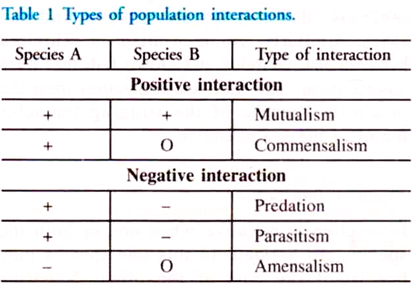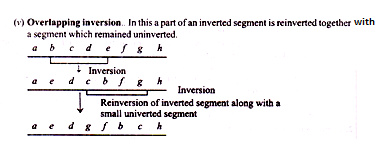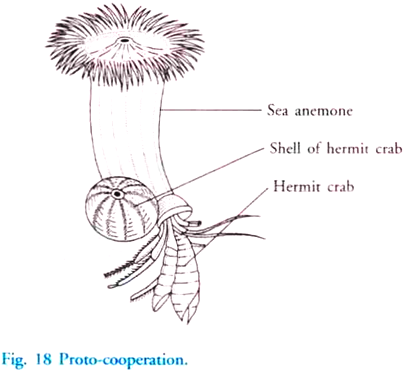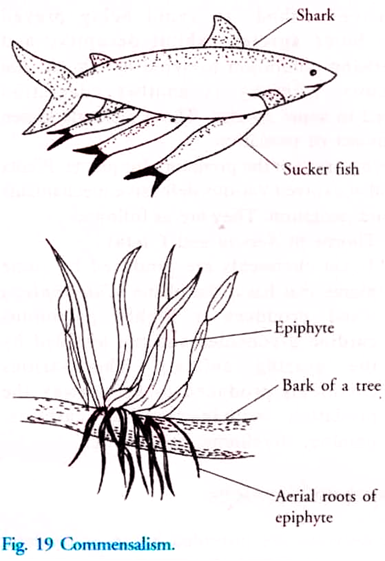ADVERTISEMENTS:
Different populations interact with each other for the sake of food, shelter and for defense purposes. Interspecific interaction arise from the interaction between populations of two different species. These interactions may be positive, negative or neutral in nature to one of the species or both. The different interactions are summarised in Table 1.
Type # 1. Positive Interaction:
Mutualism and commensalism are included in this category.
ADVERTISEMENTS:
a. Mutualism:
In this there is an interaction between two individuals or species where both the individuals benefit. The association may be very close as in symbiosis or there may not be any physical association. If both the species are completely dependent on each other and one cannot survive without other it is called obligate mutualism.
This association is a permanent association (Fig. 17); examples of obligate mutualism are as follows:
i. Association between Rhizobium and leguminous plant. In this Rhizobium fixes nitrogen for plant and in turn plant provides water and nutrients to bacteria.
ADVERTISEMENTS:
ii. Lichens:
In this algae synthesise food and fungi provide minerals, moisture and support (Fig. 17).
iii. Mycorrhizae:
This is an association between plant and fungi where fungi provide growth promoting antimicrobial substances and also help in the absorption of water, mineral and nitrogen from soil. It is found in the roots of higher plants. In turn the plant provides vitamin and carbohydrates to fungi.
iv. Plant and Animal Relationship:
Plants need animals for pollinating their flowers and dispersal of seeds. Animals in return, obtain food in the form of pollen or nectar. To avoid being cheated for the service given, the plant and animal are related very intimately with each other.
This is seen between the fig trees and the pollinating species of wasp. A given fig species can be pollinated only by its partner wasp species. The female wasp not only uses the fruit for laying eggs, but also uses the developing seeds within the fruit for nourishing its larva. The wasp in turn pollinates the fig inflorescence.
v. The orchid flower attracts only specific species of bumblebees for pollination. But here is an interesting case of ‘sexual deceit’ by the orchid to ensure pollination. The petal of the Mediterranean orchid, Ophrys, resembles the female bee in size, colour and marking. The male bee gets attracted to this petal and ‘pseudocopulates’ with this petal and in the process gets itself dusted with the pollen.
ADVERTISEMENTS:
When this bee repeats this process with another flower, it pollinates the flower. This is an example of co-evolution. Even a slight change in pattern in the female bee will reduce the rate of pollination. To ensure success, the orchid flower should also co-evolve to resemble the female bee.
When both the species can survive without each other it is called facultative mutualism or proto-cooperation. Best example of this is the association between hermit crab and sea anemone. Sea anemone provides camouflage to hermit crab and in turn is transported to new feeding places (Fig. 18).
b. Commensalism:
ADVERTISEMENTS:
In this type of association one individual or species is benefited whereas the other is neither benefited nor harmed. This association may be permanent or temporary. Examples for commensalism are – sucker fish is found attached to sharks with their suckers. Sucker fish gets protection from predators whereas it has no effect on sharks. Epiphytes like mosses, orchids, ferns, money plants grow on the trunk of other trees. They do not harm the tree but just grow to get better sunlight (Fig. 19).
The egret and the grazing cattle is another classical example of commensalism. The egret feeds on the insects found in the vegetation that the cattle graze upon. When the cattle graze on the vegetation, it stirs and flushes out the insects hidden in the vegetation which is otherwise difficult for the egret to find and catch.
Similarly, commensalism is exhibited between sea anemone and clown fish that lives among them. The fish gets protection from the predators because of the stinging tentacles found in the sea anemone.
Type # 2. Negative Interaction:
ADVERTISEMENTS:
Interaction is negative when one or both the species are harmed. In this one species may benefit at the cost of the other.
Negative interaction can be of the following types:
a. Competition:
Competition is the negative interaction between two species belonging either the same species or different species with the same needs. In this type of interaction, both the species suffer.
ADVERTISEMENTS:
Some examples are described below:
i. Plants growing in the same area compete for water, nutrients and sometimes sunlight. Different carnivorous animals compete for the same prey. For example, migratory birds such as flamingoes that visit compete with the resident fish for the zooplanktons in the lake.
ii. Sometimes even when the resource is in plenty, the presence of a ‘competitor species’ will eliminate another species. This was experimentally proved by Gause and other ecologists.
iii. The Abingdon tortoise in the Galapagos Islands became extinct in 10 years after the goats were introduced. This could be because of the greater browsing efficiency of the goats.
iv. Competitive release is a mechanism where the species which is distributed initially in a small geographical area will start expanding is range of distribution when the superior species is removed. This was demonstrated by Connell in his field experiment on the rocky coasts of Scotland.
The large superior barnacle, Balanus dominated the intertidal area and forces the smaller barnacle, Chathamalus from that zone.
ADVERTISEMENTS:
v. According to Gause’s Competitive principle, two closely related species which compete for the same resource, cannot coexist indefinitely. The competitively inferior species will be eliminated soon. But this principle is true only if the resources are limiting.
It is observed that species facing competition will evolve mechanisms that promote coexistence rather than exclusion. ‘Resource partitioning’ is such a mechanism. In this two species which compete for the same resource could avoid competition by feeding at different times or have different foraging patterns.
b. Parasitism:
In this one organism derives nutrition from the host and harms it. In this association parasites may live in (endoparasites) or on (ectoparasites) the body of the host. As it derives nutrition from the host it weakens and damages it. Examples of endoparasites are tapeworm, roundworm, threadworm, Plasmodium, etc. and ectoparasites are ticks, mites, lice, leech, etc. Cuscuta is a plant parasite and has lost its ability to photosynthesise since it derives nourishment from the host plant.
ADVERTISEMENTS:
Parasites are host specific in such a way that both the host and the parasite have coevolved. The parasites have evolved special adaptations to live successfully in a host.
ADVERTISEMENTS:
They are as follows:
i. Loss of sense organs
ii. Presence of adhesive organs or suckers
iii. High rate of reproduction
iv. Complicated life history with a primary and one or more intermediate hosts. The human liver fluke is a trematode parasite that requires two intermediate hosts, the snail and the fish to complete its life cycle. The malarial parasite (Plasmodium) requires a mosquito which is a vector to spread to other hosts.
v. Brood parasitism in bird is an interesting example of parasitism. This is seen in the cuckoo or koel bird. The cuckoo lays its eggs in the nest of the crow. These eggs resemble the eggs of crow. The crow incubates the eggs and takes care of them.
c. Predation:
In this, a stronger animal preys on a weak animal. The stronger animal is the predator and the weaker animal is the prey. Predation is a method to transfer the energy to higher trophic levels. If there is a decline in the predator population, the population of prey will increase. For example, when a tiger feeds on a deer, the tiger is known as the predator and the deer is the prey.
It keeps the prey population in control, which otherwise would lead to very high population densities and cause ecosystem instability. This is seen when exotic or alien species are introduced into a new area. It spreads fast because of the absence of its natural predators. The prickly pear introduced in Australia upset the rangeland ecosystem. It was brought under control after the introduction of the cactus feeding moth, which was its predator. In fact biological control methods of pests are based on the predator- prey relationship.
The prey species have evolved various defensive methods to avoid being preyed upon. Some species exhibit deceptive and advertising coloration to avoid or ‘shock’ the predators. Mimicry is another adaptation evolved in some species. These methods lessen the impact of predation.
Herbivores are the predators for plants. Plants have also evolved various defensive mechanisms to avoid predation.
They are as follows:
i. Thorns in Acacia and Cactus
ii. Toxic chemicals are produced by some plants that harm the plants. Calotropis, a weed produces a highly poisonous cardiac glycosides and are avoided by the grazing animals. The various chemicals produced to keep away the predators include nicotine, caffeine, quinine, strychnine, opium, etc.




